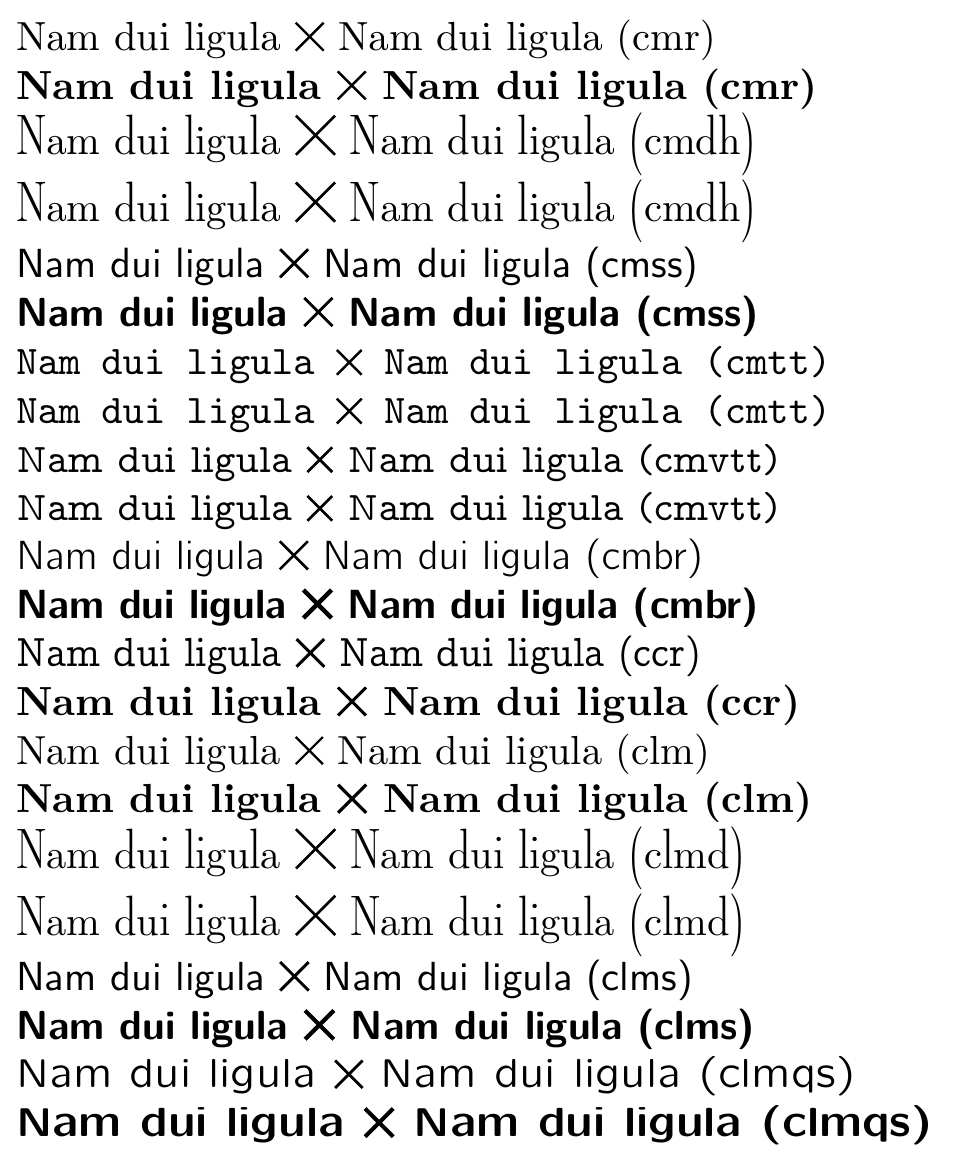**Update:**
the approach below has been bundled into the package [`BusyPanda`](https://ctan.org/pkg/panda)
```
\documentclass[varwidth,border=1pt]{standalone}
\usepackage{BusyPanda}
\newcommand{\bamboo}{%
\rule{\BusyPanda{0.125}\fontcharht\font`I}{\fontcharht\font`I}
}
\begin{document}
normal cmr: \bamboo
\bfseries
bold cmr: \bamboo
\normalfont
\fontfamily{cmbr}\selectfont
normal cmbr: \bamboo
\bfseries
bold cmbr: \bamboo
\end{document}
```

----
Different approach:
I wrote a quick [root script](https://root.cern/) to compile a test document with each font, convert it into an image and then calculate the fraction of the image, which is filled with ink. This fraction can then be used as a rough approximation of the heaviness.
Root script `MeassureInk.C`:
```cpp
#include <iostream>
#include <sstream>
#include "TASImage.h"
#include "TSystem.h"
void MeassureInk(){
const int size = 152;
double fraction[size];
int w,h;
TASImage* im;
string font[size] = {"cmr", "cmdh", "cmss", "cmtt", "cmvtt", "cmbr", "ccr", "clm", "clmd", "clms", "clmqs", "clmv", "clmt", "uaq", "pbk", "ptm", "ppl", "pnc", "pag", "phv", "pcr", "pzc", "ugq", "ugm", "ua1", "ulg", "uop", "zgmx", "qag", "qbk", "qcr", "qcs", "qhv", "qhvc", "qpl", "qtm", "qzc", "put", "Heuristica-TLF", "erewhon-OsF", "bch", "jkp", "jkpl", "jkpx", "jkp", "jkpss", "jkpss", "jkptt", "Alegreya-OsF", "Alegreya-TLF", "AlegreyaSans-OsF", "AmiciLogo", "AnonymousPro", "antp", "antt", "anttc", "anttl", "anttlc", "AccanthisADFStdNoThree-LF", "ybd", "ybv", "yes", "GilliusADF-LF", "GilliusADFNoTwo-LF", "yly", "MintSpirit-LF", "yrd", "UniversalisADFStd-LF", "yvt", "yv2", "yv1", "yv3", "yvtd", "yv1d", "yvo", "yvod", "auncl", "augie", "AuriocusKalligraphicus", "fav", "fve", "fvs", "fvm", "sqrc", "DejaVuSerif-TLF", "DejaVuSans-TLF", "DejaVuSansMono-TLF", "Cabin-TLF", "Caladea-TLF", "cantarell-OsF", "Crlt-TLF", "cmin", "Cinzel-LF", "CinzelDecorative-LF", "ClearSans-TLF", "comfortaa", "cyklop", "droidserif", "droidsans", "droidsansmono", "EBGaramond-OsF", "fbb-LF", "FiraSans-TLF", "frc", "gentium", "artemisia", "bodoni", "udidot", "neohellenic", "zi4", "iwona", "iwonac", "iwonal", "iwonalc", "JanaSkrivana", "kurier", "kurierc", "kurierl", "kurierlc", "lato-OsF", "LibreBskvl-LF", "LibreCsln-TLF", "LinuxLibertineT-OsF", "LinuxLibertineDisplayT-OsF", "LinuxBiolinumT-OsF", "LinuxLibertineMonoT-TLF", "Lbstr-LF", "LukasSvatba", "ul9", "Merriwthr-OsF", "MerriwthrSans-TLF", "nanummj", "nanumgt", "opensans-TLF", "Ovrlck-LF", "Ovrlck-LF", "PlyfrDisplay-OsF", "PTSerif-TLF", "PTSerifCaption-TLF", "PTSans-TLF", "PTSansNarrow-TLF", "PTSansCaption-TLF", "PTMono-TLF", "Quattro-LF", "QuattroSans-LF", "Raleway-TLF", "Roboto-TLF", "RobotoSlab-TLF", "SourceCodePro-TLF", "SourceSansPro-TLF", "stix", "yfrak"};
for (int i = 0; i < size; i++) {
std::cout << font[i] << std::endl;
// generating sample png
std::ostringstream cmd;
cmd << "pdflatex --interaction=batchmode '\\def\\quack{" << font[i] << "}\\input{fonttest.tex}'";
gSystem->Exec(cmd.str().c_str());
gSystem->Exec("pdftocairo -png -r 1000 -singlefile fonttest.pdf fonttest");
// open image
im = (TASImage*) TASImage::Open("fonttest.png");
w = im->GetWidth();
h = im->GetHeight();
UInt_t* arr = im->GetArgbArray();
double A[w*h], r[w*h], g[w*h], b[w*h], step[w*h];
fraction[i] = 0.0;
// read rgb values of each pixel
for (int j=0;j<w*h;j++){
UInt_t val = arr[j];
A[j] = (UInt_t)((val >> 24) & 0xFF);
r[j] = (UInt_t)((val >> 16) & 0xFF);
g[j] = (UInt_t)((val >> 8) & 0xFF);
b[j] = (UInt_t)((val ) & 0xFF);
fraction[i] = fraction[i] + (255.0-r[j])/255.0;
}
// normalise to image size
fraction[i] = fraction[i]/(w*h);
std::cout << font[i] << ": " << fraction[i] << std::endl;
}
}
```
`fonttest.tex`
```
\documentclass{standalone}
\usepackage[B1,LY1,T1]{fontenc}
\usepackage{aurical}
\begin{document}
\fontfamily{\quack}%
\selectfont
The quick brown fox jumped over the lazy dog
\end{document}
```
----
A test document using the calculated factors:
```
\documentclass[varwidth,border=5pt]{standalone}
\usepackage[B1,LY1,T1]{fontenc}
\usepackage{aurical}
\usepackage{tikz}
\newlength{\Iheight}
\newlength{\fudgefactor}
\newlength{\stroke}
\ExplSyntaxOn
\makeatletter
\newcommand{\getStrokeWD}{
\dim_set:Nn \fudgefactor {.6\fontcharht\font`I}
\dim_set:Nn \stroke {
\str_case_e:nnF {\f@family} {
{cmr}{0.143705\fudgefactor}
{cmdh}{0.117034\fudgefactor}
{cmss}{0.167922\fudgefactor}
{cmtt}{0.165045\fudgefactor}
{cmvtt}{0.181806\fudgefactor}
{cmbr}{0.149451\fudgefactor}
{ccr}{0.182321\fudgefactor}
{clm}{0.137929\fudgefactor}
{clmd}{0.114286\fudgefactor}
{clms}{0.168069\fudgefactor}
{clmqs}{0.17049\fudgefactor}
{clmv}{0.180846\fudgefactor}
{clmt}{0.162863\fudgefactor}
{uaq}{0.190493\fudgefactor}
{pbk}{0.178257\fudgefactor}
{ptm}{0.179608\fudgefactor}
{ppl}{0.160638\fudgefactor}
{pnc}{0.198033\fudgefactor}
{pag}{0.184161\fudgefactor}
{phv}{0.209548\fudgefactor}
{pcr}{0.101976\fudgefactor}
{pzc}{0.147542\fudgefactor}
{ugq}{0.346545\fudgefactor}
{ugm}{0.148205\fudgefactor}
{ua1}{0.209476\fudgefactor}
{ulg}{0.172151\fudgefactor}
{uop}{0.164666\fudgefactor}
{zgmx}{0.147344\fudgefactor}
{qag}{0.181006\fudgefactor}
{qbk}{0.183262\fudgefactor}
{qcr}{0.10322\fudgefactor}
{qcs}{0.19776\fudgefactor}
{qhv}{0.207783\fudgefactor}
{qhvc}{0.217407\fudgefactor}
{qpl}{0.162816\fudgefactor}
{qtm}{0.181038\fudgefactor}
{qzc}{0.164399\fudgefactor}
{put}{0.18489\fudgefactor}
{Heuristica-TLF}{0.187581\fudgefactor}
{erewhon-OsF}{0.187347\fudgefactor}
{bch}{0.180547\fudgefactor}
{jkp}{0.159545\fudgefactor}
{jkpl}{0.131157\fudgefactor}
{jkpx}{0.159545\fudgefactor}
{jkp}{0.159545\fudgefactor}
{jkpss}{0.170264\fudgefactor}
{jkpss}{0.170264\fudgefactor}
{jkptt}{0.14255\fudgefactor}
{Alegreya-OsF}{0.172776\fudgefactor}
{Alegreya-TLF}{0.17406\fudgefactor}
{AlegreyaSans-OsF}{0.184842\fudgefactor}
{AmiciLogo}{0.100721\fudgefactor}
{AnonymousPro}{0.150076\fudgefactor}
{antp}{0.173019\fudgefactor}
{antt}{0.178006\fudgefactor}
{anttc}{0.186403\fudgefactor}
{anttl}{0.145807\fudgefactor}
{anttlc}{0.152663\fudgefactor}
{AccanthisADFStdNoThree-LF}{0.140313\fudgefactor}
{ybd}{0.150686\fudgefactor}
{ybv}{0.162085\fudgefactor}
{yes}{0.130783\fudgefactor}
{GilliusADF-LF}{0.166004\fudgefactor}
{GilliusADFNoTwo-LF}{0.166213\fudgefactor}
{yly}{0.181598\fudgefactor}
{MintSpirit-LF}{0.171893\fudgefactor}
{yrd}{0.154166\fudgefactor}
{UniversalisADFStd-LF}{0.162126\fudgefactor}
{yvt}{0.164682\fudgefactor}
{yv2}{0.143755\fudgefactor}
{yv1}{0.157972\fudgefactor}
{yv3}{0.136458\fudgefactor}
{yvtd}{0.252267\fudgefactor}
{yv1d}{0.207436\fudgefactor}
{yvo}{0.157335\fudgefactor}
{yvod}{0.197548\fudgefactor}
{auncl}{0.172741\fudgefactor}
{augie}{0.172633\fudgefactor}
{AuriocusKalligraphicus}{0.121692\fudgefactor}
{fav}{0.197919\fudgefactor}
{fve}{0.187635\fudgefactor}
{fvs}{0.198942\fudgefactor}
{fvm}{0.170971\fudgefactor}
{sqrc}{0.264533\fudgefactor}
{DejaVuSerif-TLF}{0.186908\fudgefactor}
{DejaVuSans-TLF}{0.197323\fudgefactor}
{DejaVuSansMono-TLF}{0.167788\fudgefactor}
{Cabin-TLF}{0.205574\fudgefactor}
{Caladea-TLF}{0.188793\fudgefactor}
{cantarell-OsF}{0.17502\fudgefactor}
{Crlt-TLF}{0.206747\fudgefactor}
{cmin}{0.159805\fudgefactor}
{Cinzel-LF}{0.130158\fudgefactor}
{CinzelDecorative-LF}{0.138932\fudgefactor}
{ClearSans-TLF}{0.198669\fudgefactor}
{comfortaa}{0.16007\fudgefactor}
{cyklop}{0.328567\fudgefactor}
{droidserif}{0.196808\fudgefactor}
{droidsans}{0.196536\fudgefactor}
{droidsansmono}{0.160372\fudgefactor}
{EBGaramond-OsF}{0.147308\fudgefactor}
{fbb-LF}{0.134621\fudgefactor}
{FiraSans-TLF}{0.1985\fudgefactor}
{frc}{0.0804483\fudgefactor}
{gentium}{0.179608\fudgefactor}
{artemisia}{0.162076\fudgefactor}
{bodoni}{0.138769\fudgefactor}
{udidot}{0.15622\fudgefactor}
{neohellenic}{0.14328\fudgefactor}
{zi4}{0.156654\fudgefactor}
{iwona}{0.156578\fudgefactor}
{iwonac}{0.166489\fudgefactor}
{iwonal}{0.121128\fudgefactor}
{iwonalc}{0.127687\fudgefactor}
{JanaSkrivana}{0.102789\fudgefactor}
{kurier}{0.151921\fudgefactor}
{kurierc}{0.161325\fudgefactor}
{kurierl}{0.117323\fudgefactor}
{kurierlc}{0.123699\fudgefactor}
{lato-OsF}{0.203125\fudgefactor}
{LibreBskvl-LF}{0.175986\fudgefactor}
{LibreCsln-TLF}{0.172488\fudgefactor}
{LinuxLibertineT-OsF}{0.167461\fudgefactor}
{LinuxLibertineDisplayT-OsF}{0.142924\fudgefactor}
{LinuxBiolinumT-OsF}{0.164686\fudgefactor}
{LinuxLibertineMonoT-TLF}{0.141775\fudgefactor}
{Lbstr-LF}{0.243631\fudgefactor}
{LukasSvatba}{0.100165\fudgefactor}
{ul9}{0.178869\fudgefactor}
{Merriwthr-OsF}{0.20494\fudgefactor}
{MerriwthrSans-TLF}{0.230098\fudgefactor}
{nanummj}{0.117975\fudgefactor}
{nanumgt}{0.162379\fudgefactor}
{opensans-TLF}{0.180448\fudgefactor}
{Ovrlck-LF}{0.159994\fudgefactor}
{Ovrlck-LF}{0.159994\fudgefactor}
{PlyfrDisplay-OsF}{0.1756\fudgefactor}
{PTSerif-TLF}{0.195807\fudgefactor}
{PTSerifCaption-TLF}{0.210392\fudgefactor}
{PTSans-TLF}{0.191873\fudgefactor}
{PTSansNarrow-TLF}{0.2021\fudgefactor}
{PTSansCaption-TLF}{0.203523\fudgefactor}
{PTMono-TLF}{0.16183\fudgefactor}
{Quattro-LF}{0.145772\fudgefactor}
{QuattroSans-LF}{0.152473\fudgefactor}
{Raleway-TLF}{0.179608\fudgefactor}
{Roboto-TLF}{0.21017\fudgefactor}
{RobotoSlab-TLF}{0.214408\fudgefactor}
{SourceCodePro-TLF}{0.145125\fudgefactor}
{SourceSansPro-TLF}{0.18905\fudgefactor}
{stix}{0.181014\fudgefactor}
{yfrak}{0.183\fudgefactor}
}{0.15\fudgefactor}
}
% special cases for some bold fonts
\str_if_eq:VnT \f@series {b} {
\dim_set:Nn \stroke {
\str_case_e:nnF {\f@family} {
{cmr}{0.197865\fudgefactor}
{cmdh}{0.117034\fudgefactor}
{cmss}{0.245886\fudgefactor}
{cmtt}{0.165045\fudgefactor}
{cmvtt}{0.181806\fudgefactor}
{cmbr}{0.263226\fudgefactor}
{ccr}{0.197865\fudgefactor}
{clm}{0.193821\fudgefactor}
{clmd}{0.114286\fudgefactor}
{clms}{0.240529\fudgefactor}
{clmqs}{0.247783\fudgefactor}
{clmv}{0.221155\fudgefactor}
{clmt}{0.195427\fudgefactor}
{uaq}{0.190493\fudgefactor}
{pbk}{0.294787\fudgefactor}
{ptm}{0.259379\fudgefactor}
{ppl}{0.218724\fudgefactor}
{pnc}{0.269957\fudgefactor}
{pag}{0.286817\fudgefactor}
{phv}{0.29851\fudgefactor}
{pcr}{0.237097\fudgefactor}
{pzc}{0.147542\fudgefactor}
{ugq}{0.346545\fudgefactor}
{ugm}{0.192678\fudgefactor}
{ua1}{0.292673\fudgefactor}
{ulg}{0.172151\fudgefactor}
{uop}{0.247626\fudgefactor}
{zgmx}{0.198028\fudgefactor}
{qag}{0.290123\fudgefactor}
{qbk}{0.295368\fudgefactor}
{qcr}{0.229586\fudgefactor}
{qcs}{0.271563\fudgefactor}
{qhv}{0.297526\fudgefactor}
{qhvc}{0.298324\fudgefactor}
{qpl}{0.217954\fudgefactor}
{qtm}{0.261535\fudgefactor}
{qzc}{0.164399\fudgefactor}
{put}{0.266366\fudgefactor}
{Heuristica-TLF}{0.268307\fudgefactor}
{erewhon-OsF}{0.262209\fudgefactor}
{bch}{0.236802\fudgefactor}
{jkp}{0.211202\fudgefactor}
{jkpl}{0.178681\fudgefactor}
{jkpx}{0.211202\fudgefactor}
{jkp}{0.211202\fudgefactor}
{jkpss}{0.213081\fudgefactor}
{jkpss}{0.213081\fudgefactor}
{jkptt}{0.172506\fudgefactor}
{Alegreya-OsF}{0.261613\fudgefactor}
{Alegreya-TLF}{0.261613\fudgefactor}
{AlegreyaSans-OsF}{0.276886\fudgefactor}
{AmiciLogo}{0.150883\fudgefactor}
{AnonymousPro}{0.220943\fudgefactor}
{antp}{0.213749\fudgefactor}
{antt}{0.236086\fudgefactor}
{anttc}{0.241165\fudgefactor}
{anttl}{0.20662\fudgefactor}
{anttlc}{0.215365\fudgefactor}
{AccanthisADFStdNoThree-LF}{0.203997\fudgefactor}
{ybd}{0.196674\fudgefactor}
{ybv}{0.226247\fudgefactor}
{yes}{0.214362\fudgefactor}
{GilliusADF-LF}{0.217861\fudgefactor}
{GilliusADFNoTwo-LF}{0.219261\fudgefactor}
{yly}{0.219851\fudgefactor}
{MintSpirit-LF}{0.237611\fudgefactor}
{yrd}{0.190303\fudgefactor}
{UniversalisADFStd-LF}{0.22722\fudgefactor}
{yvt}{0.229559\fudgefactor}
{yv2}{0.202607\fudgefactor}
{yv1}{0.219529\fudgefactor}
{yv3}{0.189118\fudgefactor}
{yvtd}{0.252267\fudgefactor}
{yv1d}{0.240469\fudgefactor}
{yvo}{0.203535\fudgefactor}
{yvod}{0.197548\fudgefactor}
{auncl}{0.204576\fudgefactor}
{augie}{0.172633\fudgefactor}
{AuriocusKalligraphicus}{0.179447\fudgefactor}
{fav}{0.306534\fudgefactor}
{fve}{0.274408\fudgefactor}
{fvs}{0.306239\fudgefactor}
{fvm}{0.238433\fudgefactor}
{sqrc}{0.279584\fudgefactor}
{DejaVuSerif-TLF}{0.27131\fudgefactor}
{DejaVuSans-TLF}{0.29966\fudgefactor}
{DejaVuSansMono-TLF}{0.235061\fudgefactor}
{Cabin-TLF}{0.26225\fudgefactor}
{Caladea-TLF}{0.264705\fudgefactor}
{cantarell-OsF}{0.258705\fudgefactor}
{Crlt-TLF}{0.285776\fudgefactor}
{cmin}{0.131516\fudgefactor}
{Cinzel-LF}{0.226302\fudgefactor}
{CinzelDecorative-LF}{0.239315\fudgefactor}
{ClearSans-TLF}{0.279376\fudgefactor}
{comfortaa}{0.199374\fudgefactor}
{cyklop}{0.328567\fudgefactor}
{droidserif}{0.269543\fudgefactor}
{droidsans}{0.287283\fudgefactor}
{droidsansmono}{0.160372\fudgefactor}
{EBGaramond-OsF}{0.224536\fudgefactor}
{fbb-LF}{0.178493\fudgefactor}
{FiraSans-TLF}{0.305495\fudgefactor}
{frc}{0.0996681\fudgefactor}
{gentium}{0.179608\fudgefactor}
{artemisia}{0.217387\fudgefactor}
{bodoni}{0.186868\fudgefactor}
{udidot}{0.209602\fudgefactor}
{neohellenic}{0.220088\fudgefactor}
{zi4}{0.235073\fudgefactor}
{iwona}{0.208144\fudgefactor}
{iwonac}{0.22239\fudgefactor}
{iwonal}{0.185575\fudgefactor}
{iwonalc}{0.197149\fudgefactor}
{JanaSkrivana}{0.153915\fudgefactor}
{kurier}{0.201978\fudgefactor}
{kurierc}{0.215517\fudgefactor}
{kurierl}{0.179878\fudgefactor}
{kurierlc}{0.190939\fudgefactor}
{lato-OsF}{0.268036\fudgefactor}
{LibreBskvl-LF}{0.226337\fudgefactor}
{LibreCsln-TLF}{0.250349\fudgefactor}
{LinuxLibertineT-OsF}{0.2209\fudgefactor}
{LinuxLibertineDisplayT-OsF}{0.142924\fudgefactor}
{LinuxBiolinumT-OsF}{0.2225\fudgefactor}
{LinuxLibertineMonoT-TLF}{0.254554\fudgefactor}
{Lbstr-LF}{0.300155\fudgefactor}
{LukasSvatba}{0.150883\fudgefactor}
{ul9}{0.250776\fudgefactor}
{Merriwthr-OsF}{0.253363\fudgefactor}
{MerriwthrSans-TLF}{0.283978\fudgefactor}
{nanummj}{0.197005\fudgefactor}
{nanumgt}{0.240104\fudgefactor}
{opensans-TLF}{0.284816\fudgefactor}
{Ovrlck-LF}{0.224953\fudgefactor}
{Ovrlck-LF}{0.224953\fudgefactor}
{PlyfrDisplay-OsF}{0.259326\fudgefactor}
{PTSerif-TLF}{0.266027\fudgefactor}
{PTSerifCaption-TLF}{0.210392\fudgefactor}
{PTSans-TLF}{0.29164\fudgefactor}
{PTSansNarrow-TLF}{0.30885\fudgefactor}
{PTSansCaption-TLF}{0.283833\fudgefactor}
{PTMono-TLF}{0.249071\fudgefactor}
{Quattro-LF}{0.212042\fudgefactor}
{QuattroSans-LF}{0.217004\fudgefactor}
{Raleway-TLF}{0.179608\fudgefactor}
{Roboto-TLF}{0.301841\fudgefactor}
{RobotoSlab-TLF}{0.296934\fudgefactor}
{SourceCodePro-TLF}{0.237373\fudgefactor}
{SourceSansPro-TLF}{0.306746\fudgefactor}
{stix}{0.261034\fudgefactor}
{yfrak}{0.217662\fudgefactor}
}{\stroke}
}
}
}
\newcommand{\quack}{%
\dim_set:Nn \Iheight {\fontcharht\font`I}
\getStrokeWD
\begin{tikzpicture}[baseline]
\draw[line~width=\stroke] (0,0) -- (\Iheight,\Iheight)
(0,\Iheight) -- (\Iheight,0);
\end{tikzpicture}~
}
\newcommand{\currentfont}{\f@family}
\makeatother
\ExplSyntaxOff
\begin{document}
% list of fonts from https://tex.stackexchange.com/a/249140/36296
\foreach \macro in {
cmr, cmdh, cmss, cmtt, cmvtt, cmbr, ccr, clm, clmd, clms, clmqs, clmv, clmt, uaq, pbk, ptm, ppl, pnc, pag, phv, pcr, pzc, ugq, ugm, ua1, ulg, uop, zgmx, qag, qbk, qcr, qcs, qhv, qhvc, qpl, qtm, qzc, put, Heuristica-TLF, erewhon-OsF, bch, jkp, jkpl, jkpx, jkp, jkpss, jkpss, jkptt, Alegreya-OsF, Alegreya-TLF, AlegreyaSans-OsF, AmiciLogo, AnonymousPro, antp, antt, anttc, anttl, anttlc, AccanthisADFStdNoThree-LF, ybd, ybv, yes, GilliusADF-LF, GilliusADFNoTwo-LF, yly, MintSpirit-LF, yrd, UniversalisADFStd-LF, yvt, yv2, yv1, yv3, yvtd, yv1d, yvo, yvod, auncl, augie, AuriocusKalligraphicus, fav, fve, fvs, fvm, sqrc, DejaVuSerif-TLF, DejaVuSans-TLF, DejaVuSansMono-TLF, Cabin-TLF, Caladea-TLF, cantarell-OsF, Crlt-TLF, cmin, Cinzel-LF, CinzelDecorative-LF, ClearSans-TLF, comfortaa, cyklop, droidserif, droidsans, droidsansmono, EBGaramond-OsF, fbb-LF, FiraSans-TLF, frc, gentium, artemisia, bodoni, udidot, neohellenic, zi4, iwona, iwonac, iwonal, iwonalc, JanaSkrivana, kurier, kurierc, kurierl, kurierlc, lato-OsF, LibreBskvl-LF, LibreCsln-TLF, LinuxLibertineT-OsF, LinuxLibertineDisplayT-OsF, LinuxBiolinumT-OsF, LinuxLibertineMonoT-TLF, Lbstr-LF, LukasSvatba, ul9, Merriwthr-OsF, MerriwthrSans-TLF, nanummj, nanumgt, opensans-TLF, Ovrlck-LF, Ovrlck-LF, PlyfrDisplay-OsF, PTSerif-TLF, PTSerifCaption-TLF, PTSans-TLF, PTSansNarrow-TLF, PTSansCaption-TLF, PTMono-TLF, Quattro-LF, QuattroSans-LF, Raleway-TLF, Roboto-TLF, RobotoSlab-TLF, SourceCodePro-TLF, SourceSansPro-TLF, stix, yfrak%
}{
\normalfont
\fontfamily{\macro}
\selectfont
Nam dui ligula \quack Nam dui ligula (\currentfont)
\par
\bfseries
Nam dui ligula \quack Nam dui ligula (\currentfont)
\par
}
\end{document}
```
[](/image?hash=9ba1a054d957526eef059a4a9bc2d984a9d789cce56b14136e98680f1bd4802c)
(click in the image to see the full list)